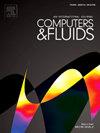Assessment of thermochemical models on nonequilibrium flowfield and radiation in shock-heated nitrogen
IF 2.5
3区 工程技术
Q3 COMPUTER SCIENCE, INTERDISCIPLINARY APPLICATIONS
引用次数: 0
Abstract
Numerical simulations based on various physical models are performed to study thermochemical nonequilibrium flowfield and radiation in high enthalpy shock-heated nitrogen flows and compared against available experimental shock tube data. The physical models include both the two-temperature (2T) model and the four-temperature (4T) model, each integrated with different vibration-dissociation (VD) coupling models. For Sharma and Gillespie’s shock tube experiment, it is observed that the 4T model demonstrates satisfactory agreement with experimental rotational and vibrational temperatures, while the 2T results fall short of achieving comparable accuracy. When employing identical equilibrium dissociation rate coefficients and energy relaxation times, the modified Marrone–Treanor (MMT) model shows the lowest dissociation rate and the highest peak rotational temperature, which is closer to experimental data, in comparison to the Park and Marrone–Treanor (MT) models. For recent experiments conducted at the Electric-Arc Shock Tube facility (Shot 37 and Shot 40), our 4T-QSS results with the MMT model give the predictions for nonequilibrium radiative metrics closest to experimental data among the three VD models considered, although discrepancies compared to the experiments are still observed. Moreover, our investigation concludes that the influences of radiative cooling, rate coefficients of associative ionization and heavy-particle impact dissociation of N2, and predissociation of the N2(C) state on nonequilibrium radiative metrics are insignificant for these two shots. The discrepancies (persisted when incorporating various modeling options) in both nonequilibrium radiative metric and radiance versus position between the present calculations and experimental measurement indicate the necessity of employing a detailed state-to-state model and considering the shock tube-related phenomena to reproduce the experimental data.
激波加热氮气中非平衡流场和辐射的热化学模型评价
基于不同物理模型的数值模拟研究了高焓激波加热氮气流中的热化学非平衡流场和辐射,并与已有的激波管实验数据进行了比较。物理模型包括两温(2T)模型和四温(4T)模型,每种模型都集成了不同的振动-解离(VD)耦合模型。对于Sharma和Gillespie的激波管实验,可以观察到4T模型与实验的旋转和振动温度表现出令人满意的一致性,而2T结果没有达到相当的精度。在相同的平衡解离速率系数和能量松弛时间下,改进的Marrone-Treanor (MMT)模型比Park和Marrone-Treanor (MT)模型具有最低的解离速率和最高的旋转峰温度,更接近实验数据。对于最近在电弧激波管设施(Shot 37和Shot 40)进行的实验,我们使用MMT模型的4T-QSS结果给出了三种VD模型中最接近实验数据的非平衡辐射指标预测,尽管与实验相比仍然存在差异。此外,我们的研究得出结论,辐射冷却、缔合电离速率系数和N2的重粒子撞击离解,以及N2(C)状态的预离解对这两个射击的非平衡辐射指标的影响不显著。当前计算和实验测量结果之间的非平衡辐射度量和辐射相对位置的差异(在合并各种建模选项时仍然存在)表明,有必要采用详细的状态对状态模型,并考虑激波管相关现象来重现实验数据。
本文章由计算机程序翻译,如有差异,请以英文原文为准。
求助全文
约1分钟内获得全文
求助全文
来源期刊

Computers & Fluids
物理-计算机:跨学科应用
CiteScore
5.30
自引率
7.10%
发文量
242
审稿时长
10.8 months
期刊介绍:
Computers & Fluids is multidisciplinary. The term ''fluid'' is interpreted in the broadest sense. Hydro- and aerodynamics, high-speed and physical gas dynamics, turbulence and flow stability, multiphase flow, rheology, tribology and fluid-structure interaction are all of interest, provided that computer technique plays a significant role in the associated studies or design methodology.
 求助内容:
求助内容: 应助结果提醒方式:
应助结果提醒方式:


